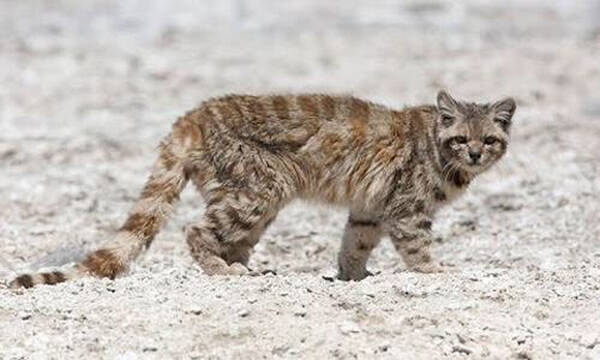Leopardus jacobita
IUCN
LCBasic Information
Scientific classification
- name:Leopardus jacobita
- Scientific Name:Leopardus jacobita,Andean Cat,Mountain cat, South American mountain cat, Andean mountain cat
- Outline:Carnivora
- Family:Felidae Ocelothrix
Vital signs
- length:57-64cm
- Weight:About 4kg
- lifetime:About 16 years
Feature
It looks like a snow leopard, about the size of a house cat, but with a longer tail, and has a shiny silver-grey coat with stripes and spots.
Distribution and Habitat
It lives in the Andes Mountains of South America, mainly in southwestern Bolivia, southern Peru, northwestern Argentina and northern Chile.
It inhabits rocky, arid, sparsely vegetated areas above the tree line of the Andes Mountains, and is limited to altitudes above 4,000 meters. The climate here is cold and windy throughout the year, with snow or sleet storms at any time. Almost all precipitation is in the form of snow, and there is almost no vegetation, no trees, only sparse shrubs.
Appearance
The Andean tiger cat is a medium-sized cat and one of the most beautiful of all wild cats. The total length is 74-85 cm, the head and body length is 57-64 cm, the tail length is 35-48 cm, the shoulder height is 36 cm, and the weight is 4 kg. The Andean tiger cat looks like a snow leopard, about the size of a domestic cat, but with a longer tail. It has a silver-grey shiny coat with stripes and spots. Its claws are retractable, the head is round, and the incisors are well developed. The back of the round ears is dark grey, and the nose is black. The fur is mainly grey in appearance, with vertical lines on the sides of the body, and continuous stripes present brownish-yellow spots. The silver-grey fur on the back is very thick, very fine and soft, up to 5 cm long. The chest and underside of the forelimbs are pale, with narrow stripes or spots of white and black, which do not form a complete ring. The soles of the feet are grey-brown.
The gorgeous tail is about 70% of the body length.
Details
Andean Tiger Cat (scientific name: Leopardus jacobita) is also known as Andean Cat, and has no subspecies.

Andean tiger cats have sharp eyesight and hearing, are good at jumping and running between steep rock walls, and feed on rodents, birds, and reptiles. They feed on rodents, lizards, insects, birds, etc. Compared with other cats, they may be more opportunistic, that is, they eat whatever they can catch.
The breeding season of the Andean tiger cat is between the months of July and August. Some experts believe that the breeding season may last longer. The cubs are usually born in spring or summer, with 1-2 cubs per litter.
The distribution of the Andean tiger cat is limited by many factors. As of 2013, the total effective population is less than 2,500. The number has been declining due to factors such as loss of prey, habitat or hunting. The Andean tiger cat is very rare in its native range, and more is known from two specimens in museums. In the distribution area, their genetic diversity is very low, so conservation work can only be carried out in a limited space when the entire race is particularly precious. Because they only live in high mountains, the valleys inhabited by humans have become barriers that separate their groups. They are hunted for sacrificial purposes in Bolivia and Chile. Their numbers are rare, even rarer than those of South American steppe cats, which also live at high altitudes. Their genetic diversity is very low in their range.
Listed in the 2016 IUCN Red List of Threatened Species ver 3.1 - Endangered (EN).
Listed in Appendix II of the Washington Convention on International Trade in Endangered Species (CITES).
Protect wildlife and eliminate game.
Maintaining ecological balance is everyone's responsibility!








